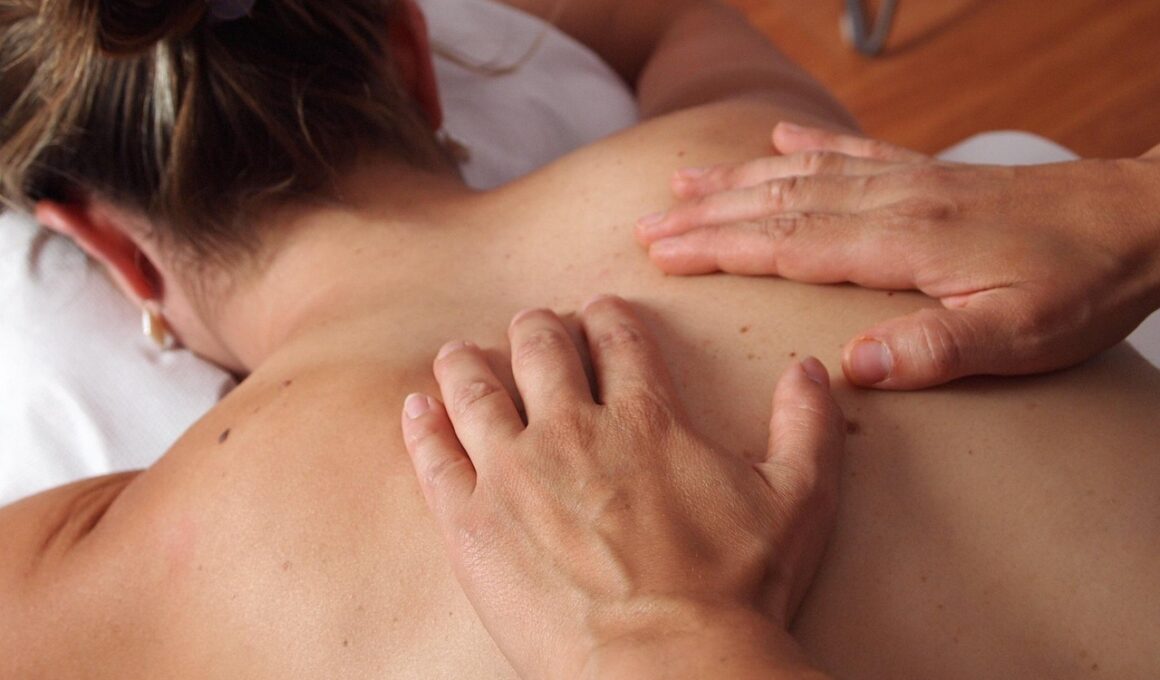The Benefits of Contrast Water Therapy for Muscles
Contrast water therapy, also known as cold and hot immersion, is an effective method for enhancing muscle recovery. Athletes and fitness enthusiasts increasingly incorporate it into their routines. This technique alternates between cold and warm water immersion, providing numerous benefits for muscle recovery. The process promotes blood circulation, reduces muscle soreness, and speeds up recovery times post-exercise. The method begins with immersion in cold water for a short duration, typically around one to three minutes, followed by five to ten minutes in warm water. Repeating this cycle helps to flush out metabolic waste while supplying muscles with fresh oxygen and nutrients. Cold exposure constricts blood vessels, which decreases swelling and inflammation, while warm exposure dilates them, increasing circulation. Consequently, this therapy becomes an integral part of workout recovery strategies. Furthermore, scientific research supports the efficacy of contrast water therapy in reducing delayed onset muscle soreness (DOMS). Regular use of this therapy can lead to improved performance and greater overall recovery between workouts. Integrating contrast water therapy into your muscle recovery routine can greatly enhance your training efforts and ensure longevity in your athletic endeavors.
One of the key advantages of contrast water therapy is its ability to alleviate soreness and muscle stiffness. After an intense workout or competition, muscles often feel fatigued and tight due to stress. Using contrast baths can significantly reduce this feeling, allowing for quicker recovery times. As the body responds to the temperature changes, a physiological response occurs that reduces pain signals sent to the brain. A study published in the Journal of Sports Science found that participants utilizing contrast water therapy reported significantly lower levels of discomfort compared to those who did not incorporate the method into their recovery. This is particularly beneficial for athletes engaged in high-intensity training regimens. Within just a couple of treatment sessions, the perceived soreness and stiffness may decrease notably. Maintaining flexibility and mobility plays a pivotal role in overall athletic performance. As the body’s recovery process improves, athletes can resume training sooner and at a higher intensity. As a simple adjunct to any workout routine, this method also provides a refreshing mental break for the body and mind, making training subsequently more enjoyable and productive while staying committed to the fitness goals.
Enhanced Circulation and Recovery
Improved blood circulation is another significant benefit of contrast water therapy. Enhanced blood flow ensures that essential nutrients and oxygen reach the muscles more effectively, supporting the healing process. During exercise, the body undergoes stress resulting in micro-tears within muscle fibers. These fibers require ample resources to repair themselves after physical exertion. Contrast water therapy’s alternating temperatures stimulate blood vessel dilation and constriction, optimizing circulation. Effective nutrient delivery boosts the body’s capacity to recover faster, beneficial for athletes transitioning to the next phase of training or competition. Moreover, contrast water therapy aids in the removal of lactic acid and other waste products accumulated during intense workouts. By assisting the lymphatic system, this therapy reduces fatigue and promotes quicker recovery times. Regular implementation of contrast water therapy has been shown to increase overall performance in athletes, leading to improved outcomes during competitions. Moreover, many individuals find that using contrast baths helps to maintain their motivation and commitment to training programs by providing an enjoyable and relaxing experience. Ultimately, engaging in just a short session of contrast water therapy can yield extensive rewards for muscle recovery.
Timing is crucial in maximizing the benefits of contrast water therapy for recovery. Engaging in this therapeutic practice shortly after intense workouts can help the body recover optimally. Ideally, athletes should utilize contrast water therapy as part of their post-workout routine. To achieve maximum benefits, it’s recommended to stay within the directed time frames for each immersion session. A combination of three minutes in cold water followed by six minutes in warm water typically works well for most individuals. This cycle can be repeated up to two or three times, ensuring that each session lasts about twenty to thirty minutes in total. However, individual preferences may vary, and experimenting with different temperatures and timings can help you find the optimal method that works for your body. Additionally, seeking guidance from a qualified trainer or physical therapist can provide further insights into personalized treatment. Furthermore, drinking plenty of water before and after a contrast water therapy session can enhance its effectiveness. Staying hydrated allows muscles to recover better and may amplify the overall benefits of this therapy.
Further Health Benefits
In addition to muscle recovery, contrast water therapy provides a wide range of benefits for overall health and wellness. For instance, the therapy can assist in reducing anxiety and stress levels commonly associated with intense training. The soothing sensation of warm water combined with the refreshing jolt of cold water can dramatically improve a person’s mood. Studies indicate that exposure to contrasting temperatures aids in releasing endorphins, providing a natural mood booster after a workout. Additionally, regular exposure to this technique may improve the immune system’s functioning due to increased lymphatic drainage and circulation. Those who consistently engage in contrast water therapy tend to report enhanced recovery from common colds and illnesses. Furthermore, many practitioners highlight the tortuous effects of hot-cold immersion on muscles, which translates to better performance during training. This can lead to longer and more enjoyable workout sessions, as athletes feel invigorated after each bath. Additionally, contrast water therapy supports subjective perceptions of well-being, making it appealing to those seeking an overall sense of relaxation and mindfulness as they strive to enhance their fitness game.
While contrast water therapy is relatively safe for most individuals, it is essential to be aware of certain precautions. People with existing health conditions, such as cardiovascular issues or sensitivity to temperature fluctuations, should consult with a healthcare professional before using this method. Pregnant women or individuals who suffer from severe skin conditions should also seek advice before immersion. Furthermore, it is vital to listen to your body during contrast water therapy, taking care not to overstress or push boundaries. Here are some tips for best practices: always start at milder temperature ranges, keep sessions short initially, and gradually increase exposure as your body adapts. For optimal results, coordinate contrast water therapy with other recovery techniques. Incorporating stretching, foam rolling, and adequate nutrition complements this therapy, encouraging the best recovery processes possible. Additionally, tracking progress can help discern how the therapy affects training outcomes. Each body is unique; therefore, remain patient with the adaptation process. Combining different techniques can lead to greater overall wellness and significantly improve performance over time, reinforcing the importance of recovery in any fitness journey.
Conclusion
In summary, contrast water therapy has proven to be an immensely beneficial technique for muscle recovery and overall health. Athletes and fitness enthusiasts alike can tap into this powerful tool to alleviate soreness, enhance circulation, and promote relaxation. While the process of alternating between hot and cold immersion may seem simple, integrating it into your post-workout routine can have profound effects on recovery times and performance. With proper timing, a clear understanding of one’s own body, and emphasis on overall wellness, anyone can benefit from this effective recovery method. Whether you’re a competitive athlete or someone simply seeking to enhance your fitness regimen, contrast water therapy is a smart addition to your routine. Consistency and attention to your body’s signals while practicing this technique are critical for maximizing results. As you continue to explore new strategies for recovery, consider the positive implications that contrast water therapy can offer. Encourage others interested in enhancing their muscle recovery efforts to explore this therapy for themselves. Prioritizing recovery within fitness goals not only enhances athletic performance but also promotes lasting health benefits for all involved.


